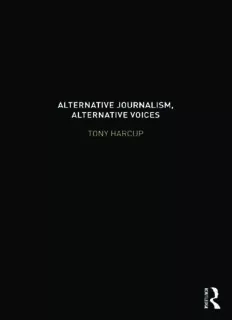
Alternative Journalism, Alternative Voices PDF
Preview Alternative Journalism, Alternative Voices
ALTERNATIVE JOURNALISM, ALTERNATIVE VOICES Bringing together new and classic work by Tony Harcup, this book considers the development of alternative journalism from the 1970s up until today. Bringingtheoryandpracticetogether,Harcupbuildsanunderstandingofalternative media through the use of detailed case studies and surveys. Including opinions of journalists who have worked in both mainstream and alternative media, he considers the motivations, practices and roles of alternative journalism as well as delving into ethical considerations. Moving from the history of alternative journalism, Harcup considers the recent spread of ‘citizen journalism’ and the use of social media, and asks what the role of alternative journalism is today. TonyHarcupisSeniorLecturerattheDepartmentofJournalismStudies,Universityof Sheffield.Hispreviouspublicationsinclude:Journalism:PrinciplesandPractice(2ndedn, 2009); The Ethical Journalist (2007); Newspaper Journalism (2010, co-authored with Peter Cole)andANorthernStar:LeedsOtherPaperandthealternativepress1974–1994(1994). ALTERNATIVE JOURNALISM, ALTERNATIVE VOICES by Tony Harcup Firstpublished2013 byRoutledge 2ParkSquare,MiltonPark,Abingdon,OxonOX144RN SimultaneouslypublishedintheUSAandCanada byRoutledge 711ThirdAvenue,NewYork,NY10017 RoutledgeisanimprintoftheTaylor&FrancisGroup,aninformabusiness ©2013TonyHarcup TherightofTonyHarcuptobeidentifiedasauthorofthisworkhasbeen assertedbyhiminaccordancewithsections77and78oftheCopyright,Designs andPatentsAct1988. Allrightsreserved.Nopartofthisbookmaybereprintedorreproducedor utilisedinanyformorbyanyelectronic,mechanical,orothermeans,now knownorhereafterinvented,includingphotocopyingandrecording,orinany informationstorageorretrievalsystem,withoutpermissioninwritingfromthe publishers. Trademarknotice:Productorcorporatenamesmaybetrademarksorregistered trademarks,andareusedonlyforidentificationandexplanationwithoutintentto infringe. BritishLibraryCataloguinginPublicationData AcataloguerecordforthisbookisavailablefromtheBritishLibrary LibraryofCongressCataloginginPublicationData Harcup,Tony. Alternativejournalism,alternativevoices/byTonyHarcup. p.cm. Includesbibliographicalreferencesandindex. 1.Journalism,Regional–GreatBritain.I.Title. PN5124.R44H372012 072–dc23 2012024267 ISBN:978-0-415-52186-4(hbk) ISBN:978-0-415-52189-5(pbk) ISBN:978-0-203-07721-4(ebk) TypesetinBembo byTaylor&FrancisBooks To Chris Searle, without whom … … who knows? CONTENTS List of tables ix Acknowledgements x Foreword by Chris Atton xi PARTI Alternative media, alternative voices 1 1 Introduction: from ‘native reporting’ to ‘native researching’ 5 2 An insurrection in words: East End voices in the 1970s 18 PARTII The alternative local press: a critical overview 33 3 A northern star: Leeds Other Paper and the alternative press 1974–1994 37 4 The alternative local press 53 PARTIII Reporting from the ground up: alternative journalism in practice 61 5 ‘The unspoken – said’: the journalism of alternative media 63 6 It wasn’t all about Arthur: alternative media and the miners’ strike 81 viii Contents 7 Reporting the voices of the voiceless during the miners’ strike: an early form of ‘citizen journalism’ 88 PARTIV Alternative media activists: motivations and reflections 99 8 ‘I’m doing this to change the world’: journalism in alternative and mainstream media 101 9 Citizens in the newsroom: democracy, ethics and journalism 120 10 Alternative journalism as active citizenship 128 PARTV Alternative media today and tomorrow 145 11 Alternative journalism: oppositional reporting in practice 149 Appendix 1: statements published in The Other Paper, LOP and Northern Star 168 Appendix 2: ‘views on the news’ 171 Appendix 3: national conference of alternative papers 176 Index 181 LIST OF TABLES 5.1 Coverage of the 1981 Chapeltown riots in the Yorkshire Evening Post 71 5.2 Coverage of the 1981 Chapeltown riots in Leeds Other Paper 72 5.3 Coverage of the initial court hearings arising from the 1981 Chapeltown riots 73 7.1 Coverage of the 1984–1985 miners’ strike in the 51 issues of Leeds Other Paper published during the dispute 92 7.2 Identifiable sources quoted or cited in the coverage of the 1984–1985 miners’ strike in the 51 issues of Leeds Other Paper published during the dispute 93 ACKNOWLEDGEMENTS Thanks to everyone at LOP from whom I learned so much; to all the alternative mediaactivistswhogavetheirtimeandansweredmyquestions;tostudents,colleagues and everyone else who has discussed alternative media with me in seminars, conferences, public meetings or in the pub; to peer reviewers for some insightful feedback; to editors and publishers for permission to reproduce material; to Chris Searle for all-round inspiration; to Cathy Leman for letting us loose in the storeroom to print our alternative school magazine; to Alan Gilbey and the other Basement Writers for being so much better than our schools expected us to be; to Chris Atton for his very generous Foreword; to Gordon Wilson for Appendix 2; to Terry Wragg forsupport,proofreadingandmuch,muchmore;andtoeveryoneatRoutledgewho helped make this book a reality. FOREWORD Local journalism, radical reporting and the everyday Chris Atton, Professor of Media and Culture at Edinburgh Napier University To speak of alternative journalism and alternative voices is inevitably to raise the longstanding spectre of definition that haunts so many studies in this field (and what we call the field is itself therefore open to argument). Once raised, it is hard to ignore. I share a preference with Tony Harcup for the term ‘alternative journalism’, for reasons of inclusiveness. This is not to deny the oppositional politics of media practicesnecessarytoJohnDowningetal.’s(2001)notionof‘radicalmedia’orthe‘citi- zens’media’ofClemenciaRodriguez(2001).Moreover,itisimportanttodistinguish Rodriguez’s radical community model of journalism from what seems a modish and banaluseoftheterm‘citizenjournalism’bycommercialmediaorganisations(although, as Xin (2010) shows, even the latter term can have radical implications in different cultural settings). Much of what Harcup addresses in this book is both radical media and community media – his essays deal with the deployment of media to enable the voices ofthe marginalised to be heard, to allow voices otherwise unacknowledged to speak to audiences unaware of their presence. As is so often said in studies of alter- native media, those unheard voices are in essence the voices of media audiences themselves. The self-reflexive activities of alternative media production thus perform radicalcritiquesonwhatitmeanstobe‘inthenews’,whatitmeanstobeanaudience and what it means to be a journalist. All of which suggests at the very least a radical cultural politics of representation – preciselytheimportthatDowningandRodriguez bring totheirchosenterms. Why, then, does this book speak of ‘alternative journalism, alternative voices’? For me, the strength of those terms – and therefore the significance of the book itself – lies in what they imply about the relationships between dominant, professionalised media and the kinds of endeavours, projects and ideologies that Harcup presents. Some readers might find the term ‘alternative’ far too vague, or redolent of a politics of lifestyle that has more to say about a culture of solipsistic detachment than about an engagement with the world through media critique and practice. Let us therefore
Description: